
November 1961. A comic hits the newsstands that would change the world of superheroes forever. That comic was “Fantastic Four #1,” created by the immortal Stan “The Man” Lee and Jack “King” Kirby, and it would usher in the Marvel era of comicdom as the flagship title of the Marvel universe for many moons. This was before Spider-Man, before the Hulk, before the X-Men. DC was riding the Justice League of America wave, and Marvel needed a response, something that would allow them to compete with the wacky comic that teamed up many superheroes for group adventures.
So Lee and Kirby did something even wackier—they took everyday people and made them into superheroes. No costumes (they would come later), no secret identities, and lots and lots of drama. The early age of Marvel was referred to as a comic book soap opera. Characters had problems, emotions, and relationships. People could relate to the characters because they had the same problems, emotions, and relationships, just without the crazy superpowers to go with them.
The Dawn of the Fantastic Four
The story begins with young Reed Richards. Reed was a brilliant scientist at State University. Deeply concerned about the space race with “the commies*,” he wanted to be the first to reach the stars. His college roommate, Ben Grimm, laughingly said that if Reed built the ship, he’d pilot the thing.
So Reed graduated and began working for an aeronautic company. Using a healthy inheritance to fund his work, he designed and built a prototype spacecraft with a new and special form of propulsion drive built to beat the light barrier. He then called Ben Grimm’s bluff; by then, Grimm was a top-notch pilot and astronaut who had gained fame by test piloting prototype aircraft. Grimm reluctantly agreed.
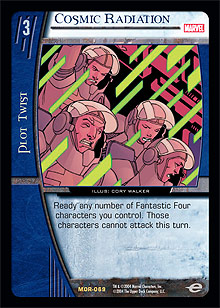 But the project ran into a setback. The government, which was providing important funding, threatened to cut off all support for the project. This was Reed’s one and only chance, and he was going to take it. Against Ben Grimm’s protests that there hadn’t been enough research and study put into the effect of Cosmic Radiation on humans, Reed stole into the launch area at night to test the prototype immediately. Ben joined him, figuring that only he could fly the damn ship. Sue Storm, Reed’s fiancee, also followed them, much to their chagrin. And to round out the trip, Sue’s younger brother, Johnny, insisted that they take him with them.
But the project ran into a setback. The government, which was providing important funding, threatened to cut off all support for the project. This was Reed’s one and only chance, and he was going to take it. Against Ben Grimm’s protests that there hadn’t been enough research and study put into the effect of Cosmic Radiation on humans, Reed stole into the launch area at night to test the prototype immediately. Ben joined him, figuring that only he could fly the damn ship. Sue Storm, Reed’s fiancee, also followed them, much to their chagrin. And to round out the trip, Sue’s younger brother, Johnny, insisted that they take him with them.
The goal was to get to another star system and then return home as heroes. But a solar flare caused increased radiation in the Val Allen Belt that flooded the ship’s cabin with cosmic rays and irradiated the crew. They lost control of the ship and crashed back to Earth. The four survived, exiting the ship and discovering that they had gained superhuman powers. Reed, who would call himself Mr. Fantastic, had malleable skin and could stretch his body as though it were rubber. Ben, who would be known as The Thing, gained superhuman strength and a thick, muscular body shell made of an orange, rocky substance that was very hard and impervious to most damage. Sue had gained the power to turn invisible, becoming the Invisible Girl. Johnny could emit super-hot plasma all over his body, literally becoming a man of flame—a Human Torch. Reed convinced the other three that they should use their powers for good and to help mankind, and they became the Fantastic Four.
Their powers essentially reflected the four elements of Earth—water, earth, air, and fire, and their cards in the game reflect those powers. The Human Torch, for example, has increasingly powerful flame powers. He goes from his Johnny Storm version, which allows you to spend endurance to boost his ATK; to his Hotshot version, which allows you to burn your opponent for 5 endurance; to his Hothead version, where the sheer heat of his flames cause endurance loss for your opponent when he’s in combat; to his Super Nova version (also reflected on the card Supernova), which allows you to pay more for an all-out ATK increase at the expense of your DEF.
The Invisible Girl’s ability reflects her invisibility—you remove a counter to negate an attack by disappearing from sight. Protector uses force shields to protect herself. Sue Storm’s reinforcement ability reflects her increasing power and her ability to generate a force field to protect herself and her teammates. Sue Richards takes that one step further, preventing Fantastic Four characters from stunning at all while defending.
Mr. Fantastic’s stretching powers are primarily represented by his range; his abilities reflect his inventions and brilliant scientific mind instead of his powers. However, his Stretch version can transfer equipment from one character to another, which reflects the utility and advantage of being able to stretch in any direction.
Similarly, The Thing has innate strength and toughness abilities. All four versions have above-average ATK and DEF levels. Ben Grimm uses anything he can get his hands on to knock out his opponents, be it a street sign or an airplane. And The Ever Lovin’ Blue-Eyed Thing is so big and strong that little guys go running far and fast when he hits the battle field.
The Adventure Begins . . .
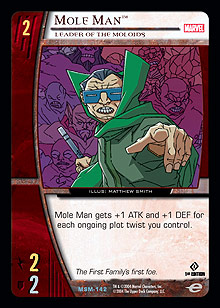 Financing the team through various patents on his inventions and the rest of his inheritance, Reed relocated the team to the top of the Baxter Building. Its game text reflects the vast stores of Reed’s inventions and experiments, all of which help the Fantastic Four ward off the many threats that menace them, New York, and the world.
Financing the team through various patents on his inventions and the rest of his inheritance, Reed relocated the team to the top of the Baxter Building. Its game text reflects the vast stores of Reed’s inventions and experiments, all of which help the Fantastic Four ward off the many threats that menace them, New York, and the world.
Their first public appearance came almost immediately when the Mole Man sent giant monsters into New York to destroy as much as possible. The Fantastic Four turned the monsters back and defeated the Mole Man. But the real threat was yet to come, and it would be a familiar face—the face of Doom.
Victor Von Doom was the son of a Gypsy healer, Werner, and a witch, Cynthia. When Cynthia made a bargain with the demon Mephisto to give her the power to save her tribe, the Father of Lies killed her and took her soul instead. Then, when Werner was being hunted down for his failure to cure a Latverian Baron’s son of cancer, he fled to the wilds and died from exposure. Victor was taken in by his father’s tribe, namely his father’s friend Boris. The young Victor vowed to have his revenge on the world for the death of his parents. 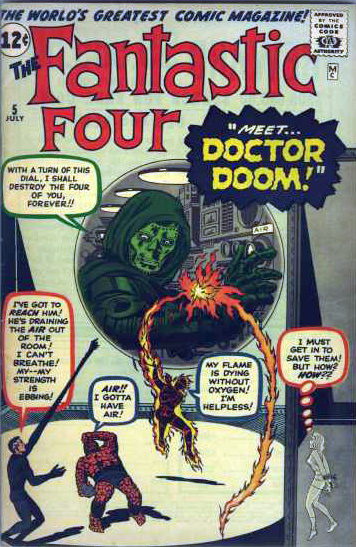
Before long, he discovered his mother’s magical herbs, potions, and artifacts. He began to study the occult and the natural sciences. To sate his lust for knowledge, he traveled around the Balkan countryside selling elixirs and potions to survive while learning more and more about the world. He focused his studies on the applied sciences, and his brilliant mind eventually came to the attention of the Dean of Sciences at Empire State University, where he was offered, and accepted, a full scholarship.
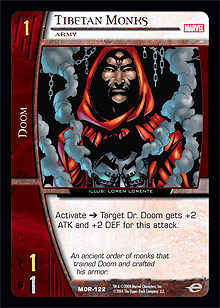 Once at ESU, he would meet a young Reed Richards, who was also studying there. Victor was experimenting on interdimensional communication, trying to find a way to speak to his dead mother. When Reed pointed out a vital flaw in his calculations, Victor scoffed at the idea that he could make a mistake and went ahead and used the device he had created. It worked for a couple of minutes (long enough to find out that his mother was trapped in Mephisto’s thrall in Hell) and then exploded, leaving Victor with a visible scar. Vanity once again reared its ugly head, and not only did Victor blame Richards for the explosion, but he also felt physically ruined by the scar. Expelled by ESU, he went into hiding. He left America for Tibet, where he would take up with—and take over—a band of Tibetan monks. There he learned more of the mystic arts and took refuge from the eyes of mankind.
Once at ESU, he would meet a young Reed Richards, who was also studying there. Victor was experimenting on interdimensional communication, trying to find a way to speak to his dead mother. When Reed pointed out a vital flaw in his calculations, Victor scoffed at the idea that he could make a mistake and went ahead and used the device he had created. It worked for a couple of minutes (long enough to find out that his mother was trapped in Mephisto’s thrall in Hell) and then exploded, leaving Victor with a visible scar. Vanity once again reared its ugly head, and not only did Victor blame Richards for the explosion, but he also felt physically ruined by the scar. Expelled by ESU, he went into hiding. He left America for Tibet, where he would take up with—and take over—a band of Tibetan monks. There he learned more of the mystic arts and took refuge from the eyes of mankind.
While in Tibet, the monks fashioned a steel mask and suit of armor for him. The mask was supposed to cover his facial scarring, but in his haste to put it on before it cooled, Victor caused more damage—he gave himself third degree burns on his face. Christening himself Doctor Doom, Victor planned to take over the world and have his revenge on Richards and everyone else who had caused him trouble.
His first step was his country of birth. Victor went home to Latveria and overthrew the government, ruling the small country with an iron fist and a totalitarian regime. He renamed his birth area, Haasenstadt, changing it to Doomstadt (which is why it gives you control of Dr. Doom and boosts his DEF), and created an utter dictatorship through a Reign of Terror and fear.
Doom fashioned a Time Platform and went back in time several times to try to defeat the Fantastic Four. He has a legion of Doom-Bots, which are exact replicas of him and often think of themselves as him (which is why they can be KO’d to ready him). He has enlisted the aid of many powerful super-beings, from Rama-Tut, to the Sub-Mariner, to the former herald of Galactus, Terrax.
In the game, the various versions of Doom reflect the many sides of the multi-faceted character. Diabolic Genius focuses on his ability to create detailed strategies and cunning traps to defeat his opponents. This is represented by his ability to flip down a plot twist (creating options for you) and prevent your opponent from playing them (eliminating options for your opponent).
Victor Von Doom further limits options for your opponents by limiting their resources. This is Doom’s bureaucratic side—stifling the opposition’s options.
Scientific Sorcerer shows how, as a dictator, Doom uses his minions to garner more power. That is similar to how various other cards on his side are used to boost him, from Tibetan Monks boosting his stats to Boris fetching what Doom needs from his deck.
Lord of Latveria displays the sheer and absolute power of Doom. The more power he has on his side, the more options he creates, and when he attacks, he is able to revitalize your attack strength.
Doom has fought the Fantastic Four over and over again throughout the years, and he has also come to their aid more than once against enemies who have threatened him. He is Doom—he does as he pleases and always looks out for numero uno.
Current Events
Over the years, many things have happened to the Fantastic Four. Reed and Sue married. Alicia Masters came into their lives and has been involved with both Johnny and Ben. She got married to Johnny, only for him to find out that he was actually married to a Skrull name Lyja who was posing as Alicia.
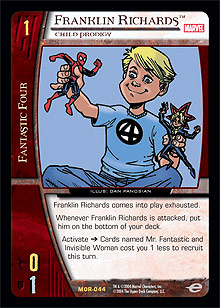 Reed and Sue had a child named Franklin Richards after her father, Franklin Storm. They would get the witch, Agatha Harkness, to take care of Franklin. Johnny would get involved with Crystal, Inhuman and then with Frankie Raye, who would become Nova, gaining Human Torch–like powers and eventually becoming a herald of Galactus. The Fantastic Four would discover the Negative Zone, fight the Skrulls, and prevent Galactus from devouring Earth. They’d also free his unwilling herald, the Silver Surfer, by threatening to use the Ultimate Nullifier.
Reed and Sue had a child named Franklin Richards after her father, Franklin Storm. They would get the witch, Agatha Harkness, to take care of Franklin. Johnny would get involved with Crystal, Inhuman and then with Frankie Raye, who would become Nova, gaining Human Torch–like powers and eventually becoming a herald of Galactus. The Fantastic Four would discover the Negative Zone, fight the Skrulls, and prevent Galactus from devouring Earth. They’d also free his unwilling herald, the Silver Surfer, by threatening to use the Ultimate Nullifier.
The Baxter Building was pretty much razed by Kristoff Vernard (a.k.a. Kristoff Von Doom, adopted son of Dr. Doom). They moved into Four Freedoms Plaza, which would be totaled by the Thunderbolts. They then moved temporarily into a warehouse named Pier 4 before Noah Baxter helped Reed rebuild the Baxter Building.
The Fantastic Four’s roster would rotate repeatedly over the years, with Reed and Sue retiring, Johnny traveling across the country with Wyatt Wingfoot, and the Thing quitting at various points. Many people have stood in, including Luke Cage, Sharon Ventura (who was also involved with Ben Grimm), Ant-Man, and She-Hulk, Jennifer Walters.
Then, a Skrull named De’Lila would defeat the Fantastic Four and—shape-shifted to look like Sue Richards—call upon Spider-Man, Hulk, Ghost Rider, and Wolverine to become the New Fantastic Four and battle the Mole Man. During this, she took Reed and searched for an egg that would hatch an Inorganic Technotroid, a powerful techno creature designed to become a loyal bodyguard to the Empress of the Skrull Empire.
More recently, Sue would have another child, one that Doom would help to deliver when Sue encountered complications and Reed was away. In return for his help, he was allowed to name the baby. He called her Valeria, naming her after the woman he loved as a young man in Latveria—the same woman he would later sacrifice as part of a pact with a cabal of demons.
Doom would take the Fantastic Four to Hell with the intention of finally defeating them. He failed, but not before reaching out and using his mystical powers to scar Reed’s face, much as Victor’s had been scarred.
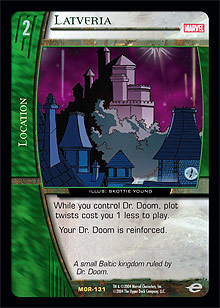 When they returned, Reed decided that with the Baxter Building nearly in ruins again, Castle Doom would make a good substitute HQ from which he could run Latveria and help free it from Doom’s shackles. But the people didn’t want Reed’s rule, and his teammates were more and more concerned by Reed’s bizarre and intense behavior, fearing that the battle with Doom and the subsequent scarring might have done some permanent damage. With the U.N. and Hungary on the verge of invading Latveria, something had to be done. Reed was becoming increasingly Doom-like in his leadership, and realizing this, he used a device to teleport himself to where Doom was banished in Hell. He was followed by the others, and Doom finagled his escape by possessing Sue.
When they returned, Reed decided that with the Baxter Building nearly in ruins again, Castle Doom would make a good substitute HQ from which he could run Latveria and help free it from Doom’s shackles. But the people didn’t want Reed’s rule, and his teammates were more and more concerned by Reed’s bizarre and intense behavior, fearing that the battle with Doom and the subsequent scarring might have done some permanent damage. With the U.N. and Hungary on the verge of invading Latveria, something had to be done. Reed was becoming increasingly Doom-like in his leadership, and realizing this, he used a device to teleport himself to where Doom was banished in Hell. He was followed by the others, and Doom finagled his escape by possessing Sue.
Meanwhile, the citizens of Latveria began to warm to the Fantastic Four and Reed’s leadership, perhaps because of his Doom-like dictatorship. Angry to see this reaction, Doom switched to Johnny, and when he discovered that the Fantastic Four had neutralized his cache of weaponry and equipment, he possessed the Thing and went ballistic. He tried to kill Johnny, forcing Reed to shoot and kill the Thing or face carnage and devastation from the possessed Thing’s strength and power.
Back in New York, the public turned on the Fantastic Four and the government froze their assets and charged them with breaking international laws and treaties. In order to get the charges dropped, Reed was forced to sign over all of his patents. Reed would spearhead a successful trip to heaven to save Grimm and help to bring the Thing back to life**.
Q&A
I’ve received some questions about the end of last week’s article and the “death” of Ra’s al Ghul. It all happened in a nine issue miniseries from last year entitled “Batman: Death and the Maidens,” by Rucka and Jansen. Ra’s dies in #9. You can get the trade paperback for about $20, which reprints the entire miniseries plus Detective Comics #783.
Questions? Comments? Send them to Kergillian (at) Hotmail (dot) com.
* As the years went by and the Cold War died down and then died out completely, the “commie” aspect of the Fantastic Four origin seemingly died with it. But the comic originally had Cold War and anti-communist propaganda and implications.
** Well, it was actually God who brought them back to life—a God who just happened to be a comic book artist who looked like Jack Kirby. Go figure . . . Especially strange since Jack Kirby, along with Stan Lee, was thrown out of Reed and Sue’s wedding. Maybe that’s why the King wouldn’t let ’em into Heaven.
Also known by his screen name Kergillian, Ben Kalman has been involved in the Vs. community since day one. He started the first major player in the online community, the Vs. Listserv, through Yahoo! Groups, and it now boasts well over 1,600 members! For more on the Yahoo! group, go to http://groups.yahoo.com/group/Marvel_DC_TCG.